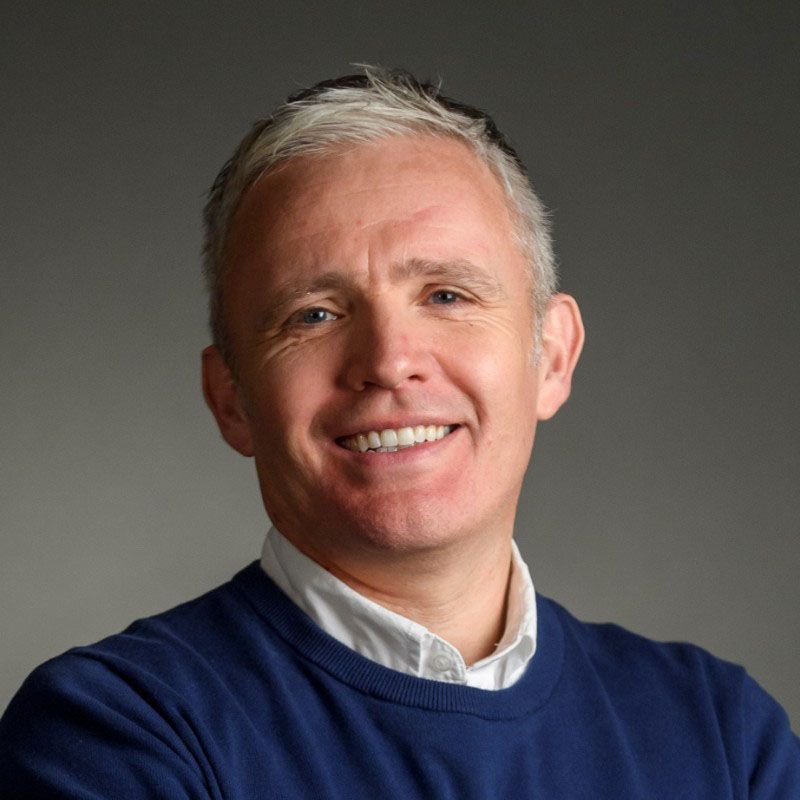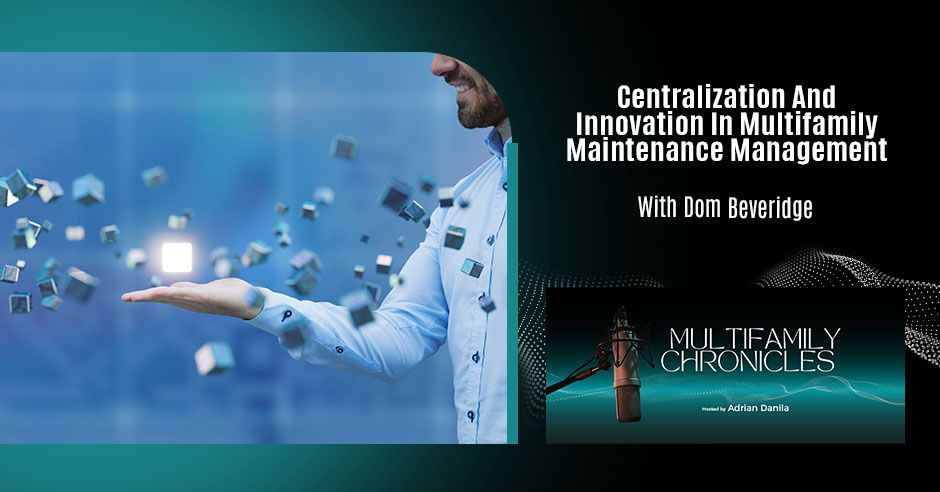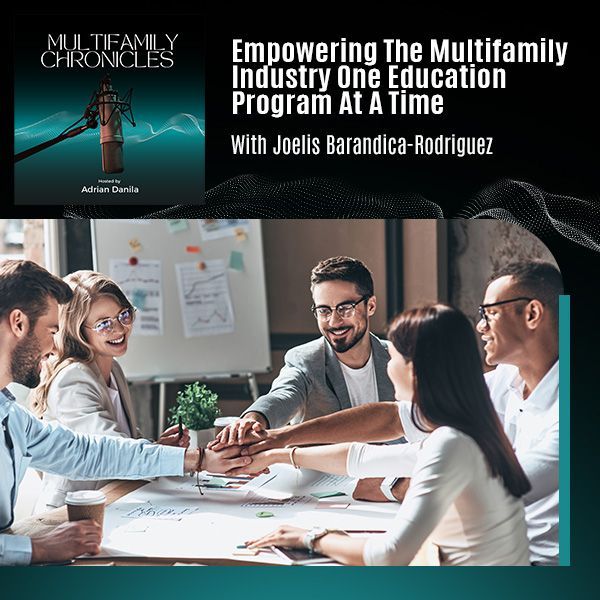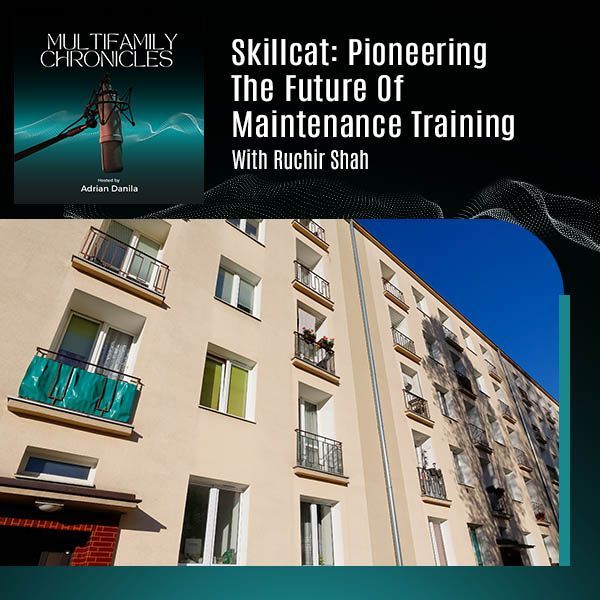Centralization And Innovation In Multifamily Maintenance Management With Dom Beveridge
Proptech and centralization are transforming multifamily maintenance management, and it's interesting how companies are discovering solutions to adapt. In this episode of Multifamily Chronicles, Adrian Danila engages in an insightful conversation with Dom Beveridge, a seasoned expert in the world of proptech and multifamily. They talk about the rapidly evolving landscape of multifamily maintenance management and discover how technology is revolutionizing the way tasks are streamlined and executed. Join in and explore the challenges and opportunities that come with centralization in multifamily property management. Gain valuable insights into the impact of proptech on maintenance, workflow optimization, and resident satisfaction. Discover the potential of AI-driven solutions, remote troubleshooting, and specialized approaches to enhance efficiency and resident experience. All these and more when you tune in!
---
Watch the episode here
Listen to the podcast here
Centralization And Innovation In Multifamily Maintenance Management With Dom Beveridge
My guest is Dominic Beveridge. Welcome to the show, Dom.
Thank you for having me.
Dom, just to start, why don't you introduce yourself to the audience a little bit? Tell us a little bit about your background.
I'm an industry consultant. I've been in multifamily for about ten years. My company is 20for20, which is a consultancy and publishing firm. That finds information about technology, about operations, and tries to explain things to the industry that it could benefit from understanding better.
Would you like to be a little more detailed about 20for20, like the white paper that you produce every year to get the audience more familiarized with your work?

The white paper became an annual thing. At the end of end of each year, I get a group of twenty executives that represent the industry. Everyone from the biggest managers to 5,000-unit owner-operators and as much as I can in between. It's ten heads of operations. COOs typically and ten heads of technology. The idea is you ask everybody the same questions. You spend a fair bit of time preparing what questions you're going to ask because you want to make sure that you're asking about stuff that's top of mind. You go through these twenty interviews, and then you synthesize what people tell you into a set of findings. That's what the white paper’s about. It seems to have some usefulness as a read on what people are working on and what's going on in the market.
One of the topics that I've seen in your white paper and also a hot topic all over social media, LinkedIn mainly where I hang out to get industry insights, is centralization for the industry. I want you to weigh in a little bit about what are the trends that you see based on the executives that you have interviewed. Also, once we go over the general state of centralization, I like to be specific and maybe discuss a little bit about maintenance centralization and what that means for the industry.
I've been diving fairly deep into centralization for the last couple of years because it was obvious that some companies had started to take radical steps towards centralizing functions like leasing, for example. I thought that everybody was now going to want to do the same thing. If there's a continuum from the present to this future state, we've got centralized leasing operations, for example. Everyone is going to be at some point on that continuum.

That was the assumption I made going into the interviews two years ago. What I found was that there is no continuum. The continuum doesn't make sense. Every company doesn't have the same opportunity to centralize things. If you don't have properties that are close together, it's quite hard to truly centralize leasing because you can't share leasing agents between properties. Even if you do have density, for example, you're a big fee manager, you don't control everything about how your properties run, your owners do. It means that you don't have the same opportunity that some of the REITs and those companies had when they made these changes to their organizations.
When I look at those things, it is more like there's a two-by-two matrix where depending on how close together your properties are and how much you control your environment, that determines what your opportunity is for centralization. That was one thing. This 2023, I wanted to get deeper into trying to understand what people are doing. We conceptualized it a year earlier. Now, I wanted to know brass tacks what's going on. We've had a couple of things.
We bucketed centralization into three areas of property management. Leasing is the thing that everybody talks about. We've got a property admin, the stuff that we normally associate with the assistant property manager, and then we've got maintenance. We look at each of those three things separately. Unsurprisingly, leasing was by far the biggest priority when you asked the question that way of the respondents.
When you ask the question differently, when you ask, "What did you do in 2022 and what are you planning to do in 2023?" you see this very different picture of what people are working on. You find that in the case of leasing, although people are rolling out leasing technologies that support centralization, most of them aren't centralizing. Very few companies are centralizing leasing operations at least so far. When you look at admin, the assistant property management role, that's the real story of centralization right now. That's the role that people are taking offsite. Lots of reasons why it makes sense to do that.
You then look at maintenance where generally the price of being able to centralize maintenance. Anything that would add flexibility to your staffing model because we know that maintenance is the hardest area to be fully staffed. The payback for managing a centralized maintenance function is the highest of those three categories, but it's the lowest in terms of activity. It's because it's difficult. Maintenance is a harder thing to do. You can't transfer skills from a high rise to a garden-style property in the same way that you can with accounting or leasing or some other skill like that. It's a difficult thing to do.
There are all sorts of interesting constraints in maintenance. If you've roughly got one person who knows how to fix elevators, HVAC, or something in each property, you don't want to have any fewer than one person per property who can do that because you could pull resources between properties. What if you had the same problem at every property at the same time? You'd now create this big problem for you that you don't have now.
There are lots of reasons why companies don't see that as being too difficult and want to push that to the end of the centralization journey. That makes sense to me as well. Generally, my read on the executives that I spoke to is that lots of executives are looking for a palatable next step that they could take with maintenance and they probably haven't seen it yet.
One of the observations that I had over the years and the challenges that I've seen in taking maintenance to the next step and the next level as far as improving services, doing things like more present 2023 versus 1990. At the top level, at the executive level, maintenance is seen solely as cost. In other words, it's not something that we could improve and make us more money or save us money, but it's strictly a cost.
How do we minimize cost? When you have this mindset of minimizing cost, there's no way you're going to invest in something that is already a cost to you because that means spending more money. Is your perception of the same type of challenges at this level when you ask about maintenance? Do you get the same feeling that I've been getting for years? That it's the mindset challenge. Not the practical challenge, but the way it's seen.
I would take a step further than that. It's not simply that they see it as a cost because centralizing maintenance could benefit your company. People who are making progress on it, you can tell it very much does benefit them from a cost perspective, which means you should do it right. The challenge is not so much that people see it as a cost. The challenge is that everybody sees it as a fixed cost. The parallel that I draw in the white paper is between single-family and what people are doing with maintenance centralization.
The challenge is not so much that people see maintenance as a cost; the challenge is that everybody sees it as a fixed cost.
In single-family, it's also a cost of maintenance. The thing is it behaves like a direct cost rather than a fixed cost. In single-family, every time a work order comes in, somebody has to decide who's doing this work, when is it going to be done, and how much should it cost. In multifamily, we've developed this coverage model where in a 300-unit property, there are three maintenance checks. They are a sunk cost. The work orders come in, their time gets consumed, and you don't have very strong incentives to get better at changing the way that they do their work.
In a single-family, if you can aggregate information about what it costs you to do different kinds of work, you can figure out cheaper ways to do it. You have to do that because every time a work order comes in, you're having to make some decisions. In multifamily where you don't have to make any of those decisions at all, where is the impetus to get better at balancing proactive versus reactive maintenance? Logically, it makes all the sense in the world to stop stuff from breaking rather than fix broken stuff. If maintenance is a fixed cost, I don't get any benefit from doing that. Why would I burn that many calories and get better at it?
It makes all the sense in the world to stop stuff from breaking rather than fix broken stuff. But if maintenance is just a fixed cost, there really isn’t a benefit from getting better at it.
That is one of the reasons in general as an industry that we're not doing a great job. It is not just like there are no funds, but even when you properly budget for some dollar numbers for preventive maintenance on a quarterly basis, the emphasis is not on doing it. We're not making a point of doing it even though it's within a budget. We try to postpone it as much as we can. That's probably a general way of looking at preventive maintenance as not seeing the value in cleaning a coil and getting a unit tuned up before it breaks down. When it breaks down, you might need a whole entire unit when it comes to HVAC.
If you were to do the proper maintenance on it, you might prolong the life of it by 1, 2, 3, or 5 years. There's a benefit, but for some reason, we're not seeing it. It's not that obvious right there. You mentioned the single-family model in maintenance. I would like to ask you, what is the opportunity for multifamily to take from the single-family model? What are some things that we could learn from them and implement successfully in our business model?
I wrote an article in Units Magazine about this. We talked about some companies that are making real tangible headway on this. There are two different models that I talked about. One is the model where you take turns out of the scope of regular maintenance. If you think about what maintenance departments do in multifamily, you can broadly split it into three chunks. There's business as usual, dealing with work orders. There's proactive maintenance, which you more flexibility as a schedule. You've then got turns, which are very spiky, sometimes you have lots of them to do and sometimes you have none of them to do kind of work, which is also predictable.
You know when this has come up to expire. You can see this big wave of work coming at some point in the future and you can see when you're not going to have any of that work to do. That lends itself to an outsourcing model. You've seen this, and in fact, Equity has written articles about this before that the outsourcing turns to a third party. If you think about that, that makes the problem of the rest of maintenance smaller. I'm not constantly being distracted by these projects that I have to do. I can now think much more in terms of, "How much of my time do I spend answering work orders? How much of my time do I spend doing proactive stuff?" Making the problem smaller by outsourcing to a third party.
In single-family, because you have to think about who's going to do this work, you don't have on-premise staff. Every time you've got some work to do, you have to decide who's going to do it. That tends to mean you've got more of a mix of vendors versus W-2 employees that are at your disposal to do this work. That's one model that is interesting.
The other one though is more simple. I use the example, Goldrich Kest was the company that we went into in some detail in the article. What they've been doing is simply changing the management structure of maintenance. Rather than having maintenance techs report to a community manager, you have them report to a regional head of maintenance. It's a low-tech thing. It's much more about marshaling the skills that you've got across a pool of properties. That for me is very much more like a single-family model. Those people happen to be assigned to individual properties, but they're behaving the way that you would in single-family where you're looking at your phone and figuring out what job you've got to go to.
What they find is that having a pool of resources available to somebody who understands how to solve maintenance problems means that you stop wasting money on stuff like, "If a door stop is broken in this property, we have to go get a vendor to come fix it. There's somebody in a sister property that knows how to fix that problem. I can send them to fix that problem whenever it comes up at one of those properties. Every time one of my resources does that, I save maybe $500 from a contractor."
You can imagine how savings like that stack up over time. For me, if you've got properties that are close enough together, it's a much more palatable step. It doesn't require that you master any technology. It just means that you are changing the reporting lines and you are starting to think much more strategically about what is the best way to do this work.
By changing whom the site maintenance personnel reports to, we could call it, in a way, centralized. They're going to answer to this regional maintenance director or whoever is part of the regional team. It is outsourcing some of the work. Would it be proper for us to define it as centralization or it's like a rearranging of? Isn't this too broad of a word?
I'm not to base semantics here but my first thought when I'm thinking about centralizing is that work is going to be done from a command center. It's going to be managed from a command center. What I'm getting from your studies and from the feedback that you've been getting, it's very little centralization. Most of it is finding more efficient ways to do things, but it is not necessary centralization. Outsourcing terms will not be to me. I wouldn't label it as that. Am I wrong in saying this?
No, you're right. One of the things that was in the white paper this year is that centralization does feel like a bit of a misnomer. It feels like it's not quite the right word. There are a couple of things that are not that helpful about it because outsourcing terms is a good example. It's quite a solid way of achieving the outcome that people are looking for when they embark on this project of centralization, but is it centralized? The fact that you outsource something to a third party. We have a name for that already. It's outsourcing. Calling it centralization for me is maybe a little bit confusing.
The other thing I noticed is, when people talk about centralization, they tend to think about technology. The thing is, the people who are good at this, even if you look at something like leasing, which has a much stronger technology requirement to it. The people who have made progress on it are the ones who get that this is not a technology problem, it's a people and process problem first that's enabled by technology. The thing is, when we talk about centralization, people jump to thinking about centralization-related technology and it completely colors the way that they think about it.
You're much better off thinking about this in terms of, "What's the people and process outcome I'm trying to drive?" When you look at maintenance, the amount of technology that you have to implement to achieve this stuff is minimal. This has far more to do with how I manage my resources and how I design my processes than it is to do with, "I need to roll out the system."
Technology came up in our conversation already. You mentioned it a few times. I have a question for you regarding technology. How can we leverage technology to support? I'm going to pause right here because I'm using the same word, which is maybe another word we want to use, centralization efforts in multifamily maintenance. Reimagining or reinventing multifamily maintenance, I'm not going to call it centralization because we already determined there is not necessary for that.
It could be a little bit of that in a case that you just mentioned where they change the reporting structure, but everything else is finding different ways and better ways maybe to address something like turnkey, but that's not centralization. It's what we'll call strict essential. I'm going to give you the opportunity here to share a few ways in which we could use technology to leverage on our behalf or to our advantage.
One of the things that interest me about maintenance tech, if you think about all of the competitors in maintenance technology products that are out there in multifamily, they're all different from each other. They come at the problem in completely different ways. The difference between maintenance platforms is much bigger, in my opinion, than the difference between CRMs, property management, or any of those software whose framing is quite consistent.
The difference between maintenance platforms is much than the difference between CRMs or properly management software.
If I think about the types of technologies that can help us to achieve this outcome that we call centralization. If we think about the use cases that we talked about, how do you make multifamily maintenance work more like single-family, where you've got greater flexibility, greater accountability, and greater ability to push the right resources towards the right job? That's a problem of gathering data from the bottom up and using it to analyze what kinds of work we do.
Going back to the Goldrich Kest example, one of the things that they were telling me was that we could imagine a world where one of our employees does HVAC. In a particular cluster of properties, we own a truck and it has an inventory of HVAC repair stuff on it. Somebody's job is to drive around our properties doing HVAC. That's the kind of job that we'll have in the future. You can imagine other kinds of specialized tasks that you'd have in a more centralized environment. How do you get there?
The answer is you have to understand what jobs overall. If I'm looking at the individual jobs that people are doing over the course of a year, first of all, how many jobs like this? How long do they take? What kind of skills, supplies, etc. do they take? Is this a job that's better done by a third party or by an external vendor? Is there enough of this kind of work that we could have a W-2 employee of our own doing this work?
The answers to all of those questions lie in building up this picture of all of the work that you do in maintenance from the bottom up in a way that we don't right now. We don't do that with work orders in multifamily. We have a very transactional view of work order as a communication thing that assigns somebody to a job. If you build the picture from the bottom up, you create this data set that enables you to understand the breakdown of your work and start making more strategic decisions about how you do it.
On top of that, you add the communication layer that allows you to collaborate with external vendors. Being better at managing your vendors, having a bench of credential vendors in a given market that you can then match to these kinds of work that you've built this picture of. Technology that works like that, of which there is some, interestingly coming from single-family, is the layer that you will put on a company that's trying to run their internet more flexibly.
I do agree with you. I stepped out of multifamily for a year, so I've done single-family. Somehow, I'm familiar enough with a single-family space to confirm that there are some models and resources that we could import into multifamily and make things better for us. They're working out there because they don't have the luxury of having someone assigned to a property that lives right around the corner or right in the backyard of their tenants.
Single-family, for the most part, institutionally scatters all over town. There's a lot of windshield time and a lot of gas money spent on driving. They then have no choice but to make things as efficient as they can, given the circumstances that they're in. They had to run things more. Specializing, having that decision tree clearly defined, "Is this going to go to a vendor to a third party or do we handle it in-house with our in-house techs?" That's a big deal. This may help benefit multifamily if they're willing to embrace this type of model, don't you think?
Absolutely. I can think of a couple of other examples of technology that exist in the marketplace right now. Another one though is the model where you've got this project management layer to the software. If you think about turns in particular, what happens with turns is that each turn is a project that contains a set of tasks that have to be implemented. The individual tasks are fairly trivial in the scheme of things.
If I'm this regional maintenance director and I'm trying to manage turns in a property, it's no good to look at individual work orders and stuff. You're going to get lost in that detail. That means I need some way to group these tasks into projects. I need things like exception-based reporting that's going to simply allow me to track. There might be dozens of turns going on at the same time I need a simple way to keep track of whether or not each of these turn projects is running on time or not.
The more project management-orientated technology is helpful for that model. I can think of other types of work to which that would apply as well. The other one or the final one that springs to my mind is this. I'm going to talk about the AppFolio example. I'm not sure if you've seen this, but they have an AI maintenance triage and dispatch capability, which again is very much modeled on the way that you do this in single-family and in smaller multifamily.
What the technology is doing in this case is I'm going to manage the interaction with the customer or with the resident. The resident is going to text, and then an AI is going to have the conversation that gets the information out of them and tells them what's going to happen, and so on. What we're also going to do is we're going to triage that work and also do the dispatch part of it. Just because you've got an AI that's able to optimize, it knows which vendors it can use, it knows your policy, and it knows what constitutes a priority. It's going to act on the data that it gets in the conversation with the residents and it's going to handle the whole triage and dispatch of maintenance resources to get problems solved.
When I look at that, if multifamily could get to an environment more like that, that would be solid progress because the AI handles the interactions well. The AI is always available. You don't need to train the AI, so you don't have problems where this person didn't realize that we're not using that vendor anymore. You get rid of all of the problems like that and you have this means of running maintenance that's much easier to manage. Those are three different ways where I see technology potentially improving maintenance.
Through my work, I've been exposed to several pieces of PropTech that do maintenance or manage maintenance. Generally speaking, most of the technology that's been developed out there deals with workflow. In other words, whether it is a work order or made ready, how do we create one? How do we complete one? How do we put the proper notes? How do we schedule when it comes to either one of them, and then how do we complete it?
Outside of that, I'll say that I haven't seen much progress. I could think of a couple of areas where a piece of PropTech will be helpful for the end user. One will be the ability to order and make it a frictionless process. In other words, I'm going to pick up my phone. The app is on my phone and I'm going to go ahead and determine what parts I need for a job or what parts I need now. Go to the main shop, and scan some barcodes where I see that my inventory is low. With a click of a button, I place an order. That'll be one thing. I don't see much of that available that's being developed.
The other one is resources for the end user. In other words, let's say that we have a group of maintenance techs or we have a large company that's using my tech. Why do I not want to develop some how-to videos that are very short, 2 to 3 minutes long on an app right there for the text? It's like a YouTube concept. On YouTube, one of the problems with YouTube is that you got to search by word, so that's going to take you a minute. Secondly, the content is not vetted. It could be good information, but you don't know. If you don't know, you don't know. You are looking for the answers, but how do you know that that's the right answer?
For companies to create a small section right there with how-to videos, that'll help them tremendously. The model exists not in a virtual world, nor an app world, but exists in MRO vendors. They all offer free training classes. If you go to HD Supply, Lowe’s Pro, or you name it, they have a long list of training classes that they offer for free to their customer. Why not develop a library section in an app that's serving maintenance? It is for maintenance to help the text.
To me, that would be an amazing selling point. I'm not sure what the cost will be for that, but I think that it'll be very high. Every time I bring it up to someone who develops an app, they're like, "We're doing workflow." I understand that that's what you're doing, but it's like an added service that will make your app more appealing. What's your take on that though?
It's a good one. You are right. It's frequently not about technology. Another good example is what HappyCo is doing at the moment with Happy Force. There, you've got an application that started as something that was targeted at inspections. There's this nice piece of software that was originally conceived to take photos of staff and record information.
What they've done is put this layer of service on top of their platform where the problem they're solving is they have remote maintenance techs who failed incoming calls and they can troubleshoot stuff on the phone with residents. The human can even gauge what the resident's appetite is, "If you like, I can order the parts off Amazon and when they arrive, I can tell you how to fix it."
That's very often a better solution than sending in your work order and waiting for a maintenance tech to come around and show you how to do it. You can imagine there are some things. I do it all the time. When something goes wrong in my house, I go look up a YouTube tutorial, and 9 times out of 10, I can fix it. I can see how you're building that into the technology platform would be smart. I also love this idea of having remote maintenance techs troubleshoot stuff on the phone with people. That was good service if I were a resident in a multifamily community.
The model exists in IT. When you buy a computer or PC and it's not working, the first thing when you call customer service, they're going to tell you to restart. Most of the time, that solves a problem. They could get into more troubleshooting, and the same goes with the cable companies. They don't dispatch texts out there. That part is very useful and helpful. I don't think that it goes too deep into troubleshooting.
I had a very terrifying experience back when I was a maintenance tech. A resident called and said, "My faucet is leaking. I can't stop the water." I try to tell them that there are some angle stops and some shadow valves inside their cabinet right under the sink. They could turn those off until I get dressed. I happened to leave on site, so I was ten minutes away. They weren't specific. They made it sound like it was going to flood the apartment. I knew the apartment had three apartments below it and that was a very scary thought. You imagine tens of thousands of dollars in damage.
Their response was like, "I tried. It won't stop the water." Valve's not working. I'm getting dressed. I'm going over there. I said, "Could you show me how you tried to stop the water?" They're looking at a valve that sticks out of the wall and instead of turning it clockwise, they were pushing it up against the wall thinking that that's how you stop it. That was a CPVC pipe.
Luckily for me, they didn't break the pipe. That would've cost tens of thousands of dollars in damage. That is a terrifying thought for anyone who's in maintenance or maintenance management or management purely for that reason. That is scary. HappyCo is trying some great things. Some of them, like basic troubleshooting, could be very helpful. It could save a lot of money, but you have to be careful how deep you want to go.
That's true. Liability, generally, is a thing. You can talk someone through how to fix their toilet, then they drop the system lid on their foot and now, you've got a different problem.
I'm not against trying it. I think for basic things it's wonderful. If you skim off the top of your workload. Let's say 10% to 15% are very easy things, like resetting the breaker, doing this, and doing the other, it's worth eliminating those three even if it's multifamily or even if it's on-site. The fact that they don't have to go to 15% of the calls and they're being handled virtually by a virtual tech, there's a lot of value in that. For sure, I'm going to be looking forward to seeing what progress they're making with the app and how successful it's going to be because there's some value in it.
The other thing I understand is that out-of-hours maintenance calls, I hadn't appreciated this. The vast majority well above 70% of all out-of-hours maintenance calls are non-urgent. When you can troubleshoot stuff on the phone, you realize it is like the stuff that you talked about. It's stuff that can wait until tomorrow. It's stuff that means, "Here's the reset button maintenance." You do have this problem. If you're sending texts to people when a call comes in, that's the worst part of the job. That's the least attractive part of being a maintenance tech. It's the fact that you have all of this out-of-hours stuff that you have to do. If you can find that you don't need to do that, that's a win as well.
A hundred percent. It also helps with employee retention, too. I conduct a lot of calls on LinkedIn and Facebook groups that are related to multifamily maintenance. I could tell you, 1 of the top 3 concerns or complaints from maintenance techs is being on call. If we could reduce the times that they had to go out on a call after hours to do whatever they needed to do, that in itself would be a huge help.
If we could reduce the times that maintenance techs had to go out on a call after hours, it would help with employee retention on the maintenance side.
It'll help with employee retention on the maintenance side if nothing else. Not to even mention the economic part because you don't have to pay that person. You don't have to pay their mileage. You don't have to pay for their time. If you could push it until the next working day, if it's a legit reason for it and it could wait, let's make it wait until the next day.
You mentioned a couple of names about who does maintenance better. I won't say who does maintenance centralization better, but who does maintenance better in the context of centralization or doing things differently. Do you have any more examples that you could share with the audience of who does things differently? Other than the regular 1 man per 100 units and they handle whatever they can handle, we can outsource.
There aren't that many examples of this. The ones that I've mentioned are probably the only ones that I know publicly about what they're doing. Generally, the other example I used in the article is a company called HomeRiver based out of Idaho. What's interesting about companies like that is they're acquisitive companies that have taken over portfolios of properties. That's how they've grown. What they were telling me about or what they had found was that they had acquired a portfolio of assets. The assets are different. They have different maintenance requirements. They've arrived at this very much that one-size-does-not-fit-all model.
The technology they were using was that thing I described earlier on where you build the picture of your maintenance from the bottom up. That was a company called Property Management. It was the IT platform that they were using. The interesting thing is when you've got a mixture of single-family, plus smaller multifamily, plus regular multifamily, you have quite a lot more innovation in that network of properties because you have a lot of different problems that you have to solve. HomeRiver seemed to me to be an example of a company that was trying to build a picture of what it needed from the bottom up and figuring out from there what the best way to address all of this work that I have to do.
One thing that I wanted to ask you, we had a previous conversation and I also saw it in the white paper that you published, fragmentation. Is this a real challenge? How big of a challenge is fragmentation in ownership for PropTech developers?
I was on a panel at AIM where we were talking about this. It's not a direct challenge at all. Overall, it's a good news story because what it means is that over the last decades when there have been very favorable lending conditions, this tells me that a lot of new investors have come to this market. That's great news. We have a much more diverse and much bigger base of investors than we did a decade ago.
I was surprised at how much bigger the fee management platforms have become or the third-party management platforms have become. The average size of the top 50 management portfolios is way bigger. It’s 60% bigger than it was a decade ago. Over the same period, the average portfolio size of the top 50 owners has gone down 20%.
More fragmentation of ownership. More properties are fee-managed than they used to be. What that means is the way that people adopt technology is different from how it was a decade ago. Anyone who gets trained in sales and marketing for a vendor and multifamily, it's ingrained in you that you are supposed to go after the COO and the CIO of the biggest owner-operators that you can find. That's the easiest way. Those people have the greatest latitude to buy many units at the same time.
For any software company, that's always been the center of the bullseye, I'm not sure that it is anymore. It is for a certain type of organization, but the average company that's implementing PropTech now is likely to be relatively small. It's likely to be fee-managed if you see what I mean. If you think about PropTech, things like connectivity, IOT, smart buildings, sensors, and any technology like that, most of the time, you're not selling it to the COO of a reach. That's not the person you are mostly selling it to. You are selling it to an individual property or a cluster of properties where you have to sell to an asset manager and a regional. The decisions are made on the basis of underwriting.
They're not thinking about it in terms of, "Across my 100,000 units, what do I want my operating platform to look like?" They're thinking about, "Does this physical stuff that I'm going to put in my property improve that property's performance or doesn't it?" You have many marginal decisions that I think are made differently from the way that we traditionally think of when we think of buying technology.
I think that the panel that I was on was interesting. It was with a couple of smaller owners who had devised their way of evaluating technologies. They'd rolled out technologies that you wouldn't have seen on the trade show floor at Optic, for example. They'd gone out and looked elsewhere. Interestingly, they both found single-family suppliers to solve these particular problems that they talked about. I generally think there's probably going to be more and more of that. Just because the market overall is getting less and less like these big owner-operators that we conventionally think of when we think about multifamily technology.

Very fascinating conversation. I could have gone for hours easily. I'm hoping that this is going to be the segue into maybe doing a second episode because I had so many other topics I wanted to cover. I ran out of time trying to stay within an hour of our conversation. I'd like to ask you in closing. What are some closing thoughts to wrap up our conversation or maybe an answer to a question I wish I would've answered in this context and I didn't for whatever reason, I didn't have a chance to or I didn't think about?
My general thing on centralization, my view is whatever work needs to be done in a multifamily property should be done wherever it can be done the most efficiently. Wherever it delivers the best resident experience or wherever it can be done to the highest degree of reliability, the most quickly. If you think about the Happy Force example, what I like about that is there's this layer of activity that is better served by having a bench of people handling that stuff remotely. That's a good assignment of effort to a task. The AI model that we talked about, the triage, and dispatch. Models like that serve this interest of specialization, which is what we talk about centralization, but specialization is more the thing that we're trying to accomplish.
Whatever work needs to be done in a multifamily property should be done wherever it can be done the most efficiently.
If somebody asked me how I make progress on centralization, I would say start with admin. Many of the tasks that we assign to assistant property managers are tasks they probably don't enjoy that much. There are some people who enjoy accounting. I don't think most people do though. There are probably some people who enjoy doing collections, but again, I don't think most people like calling people and asking them to pay their rent. When you think about tasks like that, there are better ways of doing it than saying, "Let's get the APM to do it." If you can move those tasks into a more central or more specialized environment, that's probably the least difficult centralization task. If you can get that right, you've got a much better shot at doing the rest better. That would generally be my wrap-up advice.

Dom, I hope to get you back here to continue the conversation in the future. Thank you again for being very generous with your time coming here to talk with me. To share this with the audience is very powerful. Thank you again.
I enjoyed the conversation. Thank you.
Everybody, I hope to see you back here soon. Have a great day.
Important Links
- Dominic Beveridge
- 20for20
- Units Magazine – Multifamily’s Tentative Progress Toward Maintenance Centralization article
- Goldrich Kest
- AppFolio
- HappyCo
- Happy Force
- HomeRiver
About Dom Beveridge






